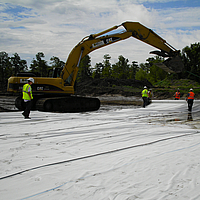WBV-72 East-West Levee
Project information
WBV-72 East-West Levee
St. Charles Parish, US
WRS Compass Contracting
March 2010 - June 2011
Project details
In 2005 Hurricane Katrina produced storm surge which breached the New Orleans Levee System and caused billions of dollars in damage to the greater New Orleans area. In the aftermath of the hurricane and the resulting destruction, federal legislation provided for funding needed to rebuild the New Orleans Levee System. To meet the ultimate goal of protecting property in and around New Orleans, the US Army Corps of Engineers (USACE) designed a levee system which would provide 100-year flood protection. Varying design and construction techniques, some of which included geosynthetic reinforcement, were used in the levee improvement projects. WBV-72 was one of several levees that incorporated geosynthetic reinforcement in design and construction.
WBV-72 is part of the Westbank and Vicinity (WBV) Hurricane Storm Damage and Risk Reduction Lake Cataouatche, Western Tie-In System. WBV-72 is a clay levee, 2.8 miles long which included 2.4 miles requiring construction improvements to an elevation of 13.5 ft. After considering options, the USACE decided geosynthetic reinforcement was the most economical and least time consuming technique to increase the unacceptable shear strength of the levee foundation soil.
In March of 2010, construction of WBV-72 was awarded to WRS Compass Contracting out of Tampa, FL. WRS accepted the award knowing that construction of the WBV-72 levee must be completed by June of 2011. Project plans called for the new levees to be offset behind the existing levees and increasing height to elevation 13.5'. Since geosynthetic reinforcement is needed below the levee and during early phases of construction, finding a reinforcement supplier was a high priority. During the bidding portion of the project, HUESKER, Inc. suggested using custom length panels to closely meet planned geotextile limits which reduces waste and construction time. To keep material cost down, HUESKER, Inc. also proposed a custom produced geotextile that closely met the 5% wide width tensile strength properties of the project.
In the end, six roll lengths were produced to optimize material efficiency. Due to varying levels of shear strength experienced in the levee foundation soil, the USACE designed five geotextile strengths based ultimate strength at 5% values. HUESKER, Inc. proposed 3 custom produced geotextiles to most economicaly meet the project requirements. Because of HUESKER, Inc. ability to produce high strength at low strain polyester geotextiles, ultimate strengths at 5% were achieved while maintaining the economic goals of the project. Geotextiles provided an option to over excavation and replacement of existing site soil which resulted in a significant cost and time savings.
In conclusion, the geotextiles provided an economical and viable design and construction option for the WBV-72 levee improvements.

